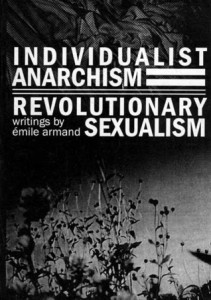THE INDIVIDUALIST ANARCHIST INITIATION
Some lines of introduction
In 1908, I published, through the group of “Causeries Populaires,” then under the influence of comrade Libertad, a study entitled What is an Anarchist? In it, I tried to situate “the anarchist” in relation to their ambiance and to their own milieu.
Since then, events have advanced. Faced with misunderstandings and confusions, the idea came to me, in the course of the war which ravaged Europe, to locate not the “anarchist”—a term then rather vague and lending itself to ambiguity—but the anarchist individualist, in relation to the social milieu in general and to the individualist theory in particular. The detention to which I was then subject did not permit me to complete my project. However, it was realized in part by the publication, in Spanish, of a revision of my first work under the title El Anarquismo individualista, lo que es, puede y vale.
The crisis ended, the same ambiguities remain. Many of the best among us do not have the time to look back on the controversies to which “anarchist individualism” have given rise. They lack some elements, some necessary references to free that aspect of individualism from the dross, the muck, and the compromises under which one has water to tarnish it, cloak it, if not make it disappear. In the first place, this work aims to furnish an idea, a representation and a perspective on anarchist individualism–of its essence and its demands–as clear as my own knowledge of the subject allows. Although after much thought I have seen fit to retain a certain number of pages from “What is an Anarchist?” the reader will quickly see that it is anything but a simple overhaul of that work. It has, however, in common with that volume that several of its chapters have been written in prison–at the cost of some difficulties, alas !
The distinct character of this volume, what distinguishes is not only from “What is an Anarchist?” but also from all which has been published to date on individualism envisioned from the anti-authoritarian point of view, is its lack of unilateralism, to say nothing of homogeneity. The pages which follow do not develop a single conception: they outline, describe, or at least examine the different manifestations of anti-authoritarian individualist thought and aspirations, from simple anti-statism to pure the negation of society. The tendency which wants the “self” to express itself in a reasonable restriction of needs and a rational simplification of its existence occupies a place in it analogous to that which believes that the flowering the of the “self” is only possible through the intensification of the desires, the Dionysian enjoyment of the pleasures of life.[1] These diverse manifestations respond to, compensate for, and compete with one another. They give to the individualist idea, in the sense in which we mean it, a character of extraordinary grace and flexibility. They differ so much that they appear contradictory. They almost seem mutually exclusive. All things considered, the contradictions and oppositions are only apparent. A common bond keeps them cemented together: the negation, rejection, and hatred of domination and exploitation; the absence of obligation, sanction, and encroachment in every domain; the abolition of the constraint of the herd on individual initiative and impulse.
You will understand the reasons that this attempt to reveal the multiple facets of the anarchist individualist thesis has been given the significant title of Initiation: a name that would have been meaningless if it had only been a question of explaining a single aspect of that individualism. That has naturally not prevented me from peppering this volume with very individual interpretations and commentaries on the individualist “way of life.”
But, in my thought, the Individualist Initiation is not simply an acknowledgment, or a briefing, on anarchist individualist thoughts, deeds, and will. This work is an instrument of labor, a tool of propaganda, and a weapon of combat. This explains the frequent repetitions, the numerous retellings, and the repeated demonstrations. I have not wanted to end a paragraph, to pass to a new chapter without striving to say all that could be said on the subject, even at the expense of “style.”[2]
Doubtless, of the opinions expressed, the propositions set down, and the points of view explained, some are hardly outlined, while others are too developed; however, such as it is, I am convinced that this work could lead many to develop their own idea of anarchist individualism, or in any case to meditate seriously on the problems which are posed or considered here.[3]
October 1, 1923.
[1] The Individualist Anarchist Initiation is divided into two parts, each printed in slightly different characters. The first treats the theoretical bases, and the second some practical theses of anarchist individualism. Let us be quick to note that this classification is somewhat arbitrary; in reality–because they are the result of reflection or individual experience–practice and theory constantly aim to find agreement.
[2] One will find at the end of the volume and alphabetical index of references and connections, the compilation of which has been entrusted to the care of comrade Germaine P… It is conceived in a manner to effectively aid in their research, those of the readers of this work who consider it more particularly as an instrument of study.
[3] It goes without saying that the term individualist, used alone, indicates exclusively the anti-authoritarian or anarchist individualist; explicit mention is made where this is not the case.
